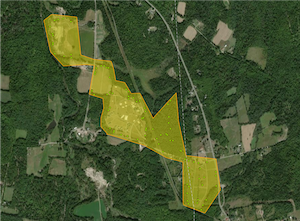By Noah Gleason-Hart, MOFGA’s Low-Impact Forestry Specialist
Like many landowners in Maine, MOFGA has a significant and growing non-native and invasive plant population in our forest. We’ve carried out some control work in the past, but the recommendations in our recently updated forest management plan made it clear that if we intend to maintain an ecologically complete forest into the future, we need to prioritize comprehensive control work now. Many landowners are in a similar situation, and I hope that sharing why MOFGA has decided to manage invasive plants and how we plan to carry out the work may be helpful to others who are unsure where to begin.
Why Are We Trying to Manage Invasive Plants at MOFGA?

An invasive plant is not simply a non-native plant; according to the Maine Natural Areas Program, there are approximately 700 non-native species in Maine, but only a handful are considered invasive. Instead, invasive plants are non-native plants that disrupt forest processes by aggressively out-competing native vegetation. Many were unwittingly introduced as landscape plants or promoted by conservation groups for erosion control or as soft mast producers for wildlife.
Forests are constantly changing and adapting, and are amazingly resilient in the face of human-induced and natural disturbances. However, every system has limits, and some non-native plants, lacking the competitors or conditions that controlled their populations in their original environment, overwhelm a forest’s ability to function. For example, if a woodlot has many invasive shrubs in its understory, new trees can’t regenerate as older trees die or are harvested. Over time, tree numbers would decline as low shrubs dominated the stand. This might provide some ecological benefits, but would not support the same wildlife species, provide forest products for human use, or sequester and store as much carbon as a functioning forest.
It’s important to note that our goal is control, not eradication. It is unlikely that we will fully and permanently keep invasive plants out of our forest; they are too numerous and seed sources are everywhere. Instead, our goal is to drastically reduce populations and keep invasive species in check so natural forest processes can continue.
There is also no doubt that we should be thoughtful of which plants we label as “invasive” and mindful of how the solutions we propose impact forests. However, MOFGA has decided that invasive plants are a human-introduced problem in our woods that we should address as thoughtful land stewards committed to interacting with forested ecosystems in constructive ways.
Planning and Methods
Conventional approaches to invasive plant control rely on herbicide applications, which are incompatible with MOFGA’s principles. We recognize that mechanical removal is exponentially more time-consuming and difficult, so we wanted to have a clear plan of action in place before we began working. In 2020, we learned about invasive plant planning funding available at the time from the Natural Resources Conservation Service (NRCS) and enlisted the help of the Waldo County Soil and Water Conservation District (WCSWCD). The completed plan provided us with invaluable maps showing concentrations of plants across the property, prioritized species for control work, and suggested species-specific treatment methods and timing.

As a first step in the implementation process, we held a workshop at MOFGA where Aleta McKeage, the technical director at WCSWCD, demonstrated mechanical control techniques and discussed tactics and strategies to maximize the impact of our control efforts. We practiced using tools from weed wrenches to tractors to pull plants. We also discussed consistent mowing or high-intensity grazing and tarping to starve plants of light and nutrients as tools in the organic invasive control toolbox. To increase the effectiveness of these techniques, McKeage also recommended five broad implementation strategies.
First, prioritize the species that are not yet common on your property. For example, the invasive inventory conducted for our plan noted only two small patches of Japanese knotweed (Fallopia japonica), and McKeage recommended prioritizing aggressive mowing or tarping to make sure knotweed does not become established on the property.
Second, time the treatments with your other management activities. We plan to continue thoughtful logging in our forest to increase species and age diversity and produce products for MOFGA use. Before we cut trees in a given area, we should remove understory invasives so they don’t benefit from increased light after the harvest and hinder regeneration.
Third, starting along the edge of an infestation and gradually working inward contains further expansion. Also, with species like shrubby honeysuckle (Lonicera morrowii and L. tatarica) that reproduce by seed, removing what McKeage called “mother” plants — large, vigorous specimens that produce heavy seed crops — can drastically reduce germination of new seed.
Finally, follow-up is critical. Soil seed banks can be viable for years and root fragments we miss will resprout, so we should plan to return annually to monitor and remove new plants as needed.
Funding and Implementation
MOFGA’s forest management plan recommends that we complete 12 acres of control work over the next decade. It’s is a big project and to support this multi-year effort MOFGA has applied for NRCS invasive control funding. This federal reimbursement program provides funding on a per-acre basis to help us cover the costs of tools and labor. If we receive funding, we plan to start hands-on work on an acre of ground in the summer of 2022. If you’d like to be a part of that effort, reach out. When it comes to pulling invasive plants, many hands really do make light work!
You can find a list of invasive plants in Maine, and learn more about control strategies, including organic options, at the Maine Natural Areas Program website.
Noah Gleason-Hart is MOFGA’s low-impact forestry specialist. You can contact him at [email protected].
